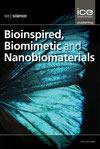Structural investigation of Amphibalanus amphitrite cement proteins: an in-silico study
IF 0.6
4区 工程技术
Q4 ENGINEERING, BIOMEDICAL
引用次数: 0
Abstract
Balanomorpha, commonly known as barnacles, are leading biofouling animals belonging to subclass Cirripedia that adhere durably to different submerged surfaces by utilizing a chiefly-proteinaceous cement. According to prior experiments, adhesion is most likely made possible by the self-assembling aggregates reputed as amyloid-like nanofibers. The secreted cement contains numerous proteins among which CP19k and CP20k are thought to have a substantial influence on the adhesion process. The molecular configuration and atomistic interactions that result in this firm cement are not yet completely understood. Herein, AI-based structure prediction and molecular dockings were used to inspect the potential role of AaCP19k and AaCP20k-1 of Amphibalanus amphitrite in the formation of amyloid-like nanofibers. The anticipated structure of AaCP19k was highly accurate and its β-sandwich folding had a close resemblance to cross-β motifs found in amyloid nanofibers. In the AaCP19k, β1-2 and β7-8 act as oligomerization sites where stable dimers and trimers can be assembled. These modeled oligomerization interfaces point to the self-assembly site through which fibrillization might happen. The structural flexibility of AaCP20k-1 yielded low-accurate models, but a conserved β-hairpin and an α-helix were evident with high confidence. These structural properties can be employed in prospective studies to develop bioadhesives and design anti-fouling substances.Amphibalanus amphiitrite水泥蛋白的结构研究:一项计算机研究
藤壶,通常被称为藤壶,是一种主要的生物黏附动物,属于藤壶亚纲,通过利用主要的蛋白质黏附物持久地附着在不同的水下表面。根据先前的实验,粘附最有可能是由被称为淀粉样纳米纤维的自组装聚集体实现的。分泌的水泥含有许多蛋白质,其中CP19k和CP20k被认为对粘附过程有重大影响。导致这种坚固水泥的分子结构和原子相互作用尚未完全了解。本文采用基于人工智能的结构预测和分子对接技术,研究了Amphibalanus amphitrite的AaCP19k和AaCP20k-1在淀粉样纳米纤维形成中的潜在作用。AaCP19k的预期结构非常精确,其β-三明治折叠与淀粉样蛋白纳米纤维中的交叉β基序非常相似。在AaCP19k中,β1-2和β7-8作为寡聚位点,可以组装稳定的二聚体和三聚体。这些模拟的寡聚化界面指向可能发生成纤维的自组装位点。AaCP20k-1的结构灵活性模型精度较低,但保守的β-发夹和α-螺旋具有较高的置信度。这些结构特性可用于前瞻性研究,以开发生物粘合剂和设计防污物质。
本文章由计算机程序翻译,如有差异,请以英文原文为准。
求助全文
约1分钟内获得全文
求助全文
来源期刊

Bioinspired Biomimetic and Nanobiomaterials
ENGINEERING, BIOMEDICAL-MATERIALS SCIENCE, BIOMATERIALS
CiteScore
2.20
自引率
0.00%
发文量
12
期刊介绍:
Bioinspired, biomimetic and nanobiomaterials are emerging as the most promising area of research within the area of biological materials science and engineering. The technological significance of this area is immense for applications as diverse as tissue engineering and drug delivery biosystems to biomimicked sensors and optical devices.
Bioinspired, Biomimetic and Nanobiomaterials provides a unique scholarly forum for discussion and reporting of structure sensitive functional properties of nature inspired materials.
 求助内容:
求助内容: 应助结果提醒方式:
应助结果提醒方式:


